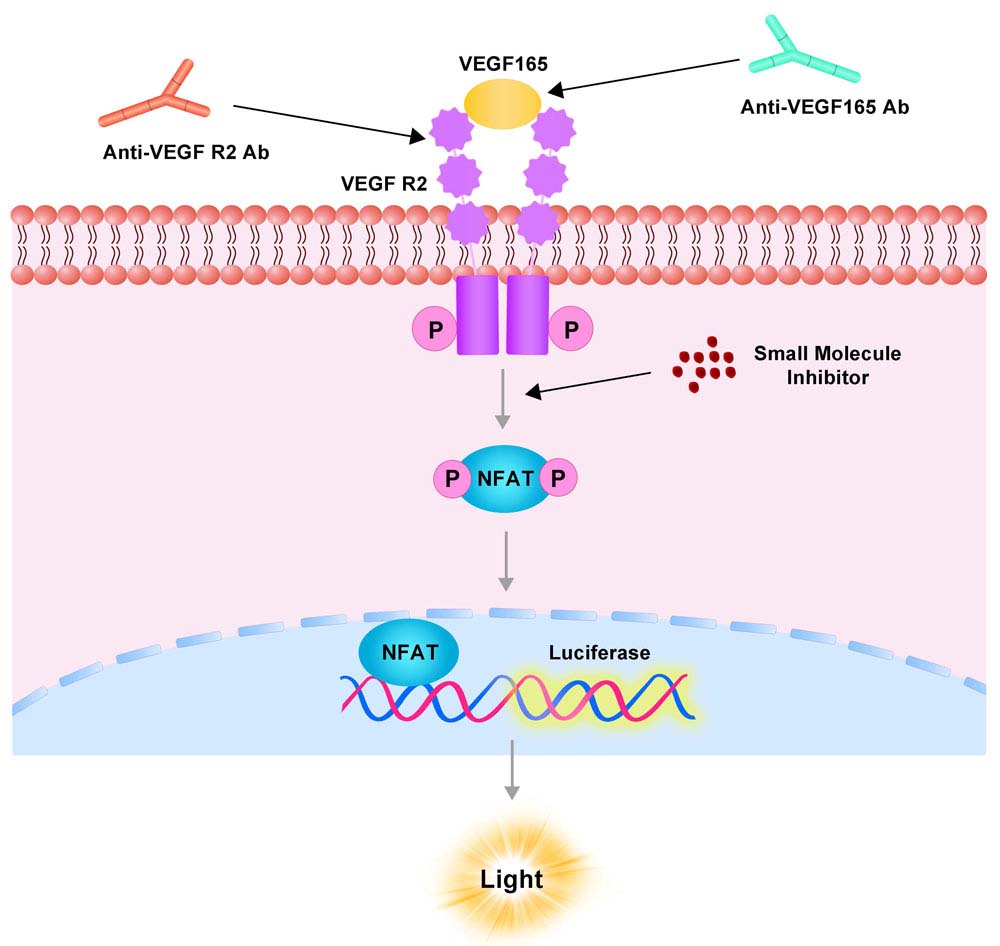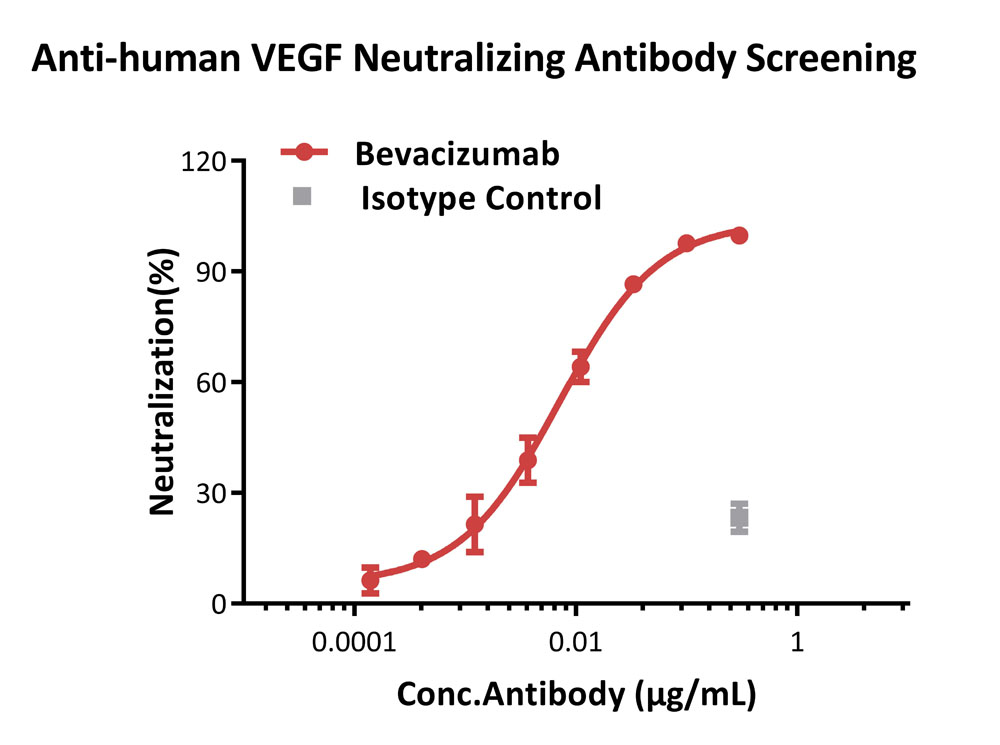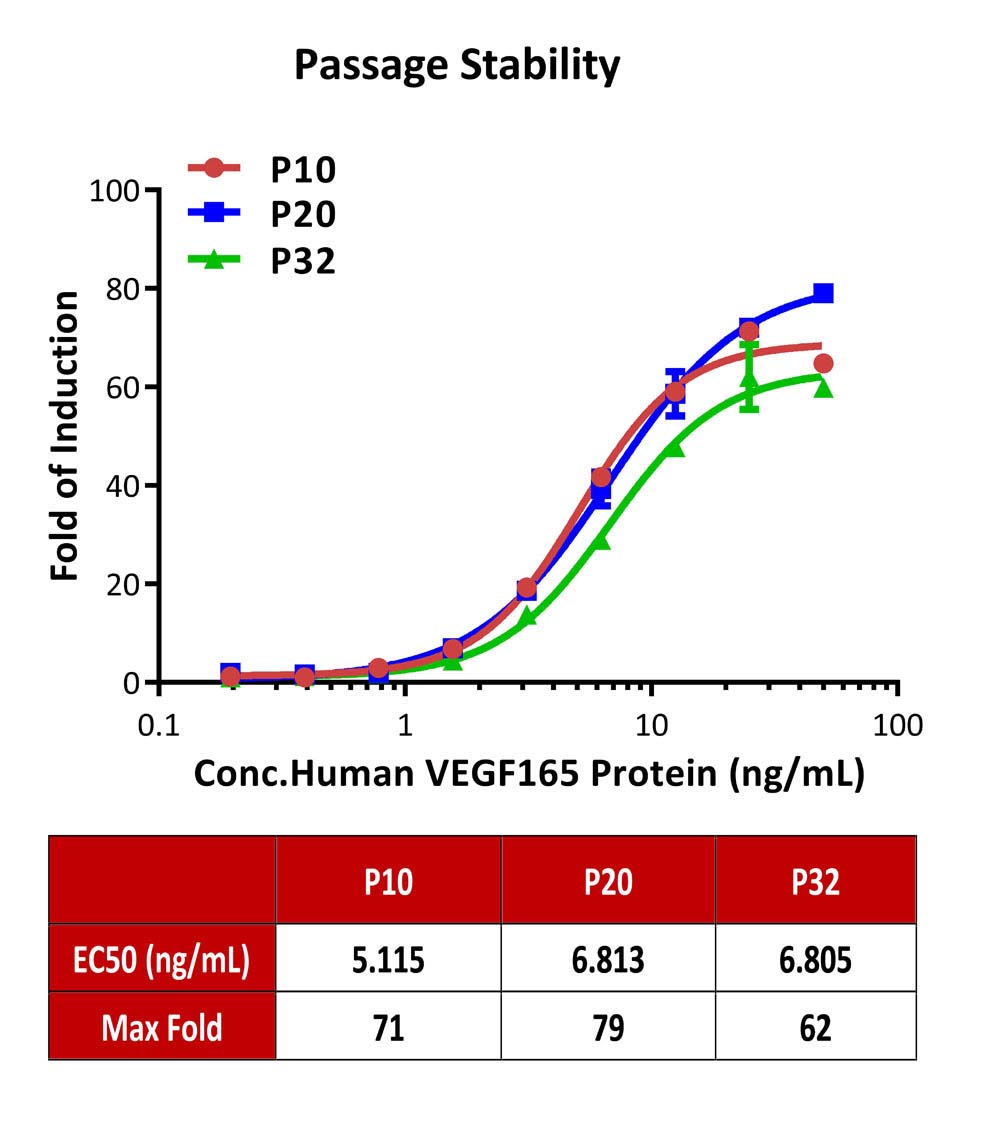- Genetically modified cell lines best reflect MOA (Mechanism of Action)
- Higher activity and larger assay window for robust and reproducible cell-based bioassay
- Comprehensive application data to support assay development and validation
- Full tracible record, stringent quality control and validated cell passage stability
- Parental cell line legally obtained from internationally recognized cell resource bank and commercially licensed
- Global commercial license assistance whenever regulatory filing is required
描述(Description)
The Human VEGF R2 (Luc) HEK293 Reporter Cell was engineered to not only express NFAT signaling response element, but also express the receptor full length human VEGF R2 (Gene ID: 3791). When stimulated with human VEGF protein, the VEGF/VEGF R2 interaction drives NFAT-mediated luminescence. Inhibition of VEGF binding to VEGF R2 by either anti-VEGF or anti-VEGF R2 antibodies results in a decrease in luminescence.
应用说明(Application)
• Screen for anti-human VEGF R2 or anti-human VEGF neutralizing antibody.
• Screen for human VEGF R2 small molecule inhibitor

生长特性(Growth Properties)
Adherent
筛选标记(Selection Marker)
Hygromycin B (20 μg/mL) + Puromycin (2 μg/mL)
培养基(Complete Growth Medium)
DMEM medium + 10% FBS
冻存液(Freeze Medium)
Serum-free cell cryopreservation medium
装量(Quantity)
1 vial contains at least 5×10^6 cells in 1 mL serum-free cryopreservation medium
存储(Storage)
Frozen in liquid nitrogen.
支原体检测(Mycoplasma Testing)
Negative
无菌检测(Sterility Testing)
Negative
使用说明(Instructions for Use)
See data sheet for detailed culturing and assay protocol.
Receptor Assay

Expression analysis of human VEGF R2 on Human VEGF R2 (Luc) HEK293 Reporter Cell by FACS.
Cell surface staining was performed on Human VEGF R2 (Luc) HEK293 Reporter Cell or negative control cell using PE-labeled anti-VEGF R2 antibody.
Protocol
Application

Inhibition of human VEGF165 protein-induced reporter activity by anti-human VEGF neutralizing antibody.
This reporter cell was incubated with serial dilutions of antibodies in the presence of human VEGF165 protein (Cat. No. VE5-H4210) with a final concentration of 10 ng/mL. The EC50 of anti-human VEGF neutralizing antibody (Bavacizumab) is approximately 0.0071 μg/mL.
Protocol

Inhibition of human VEGF165 protein-induced reporter activity by human VEGF R2 small molecule inhibitor.
This reporter cell was incubated with serial dilutions of inhibitors in the presence of human VEGF165 protein (Cat. No. VE5-H4210) with a final concentration of 10 ng/mL. The EC50 of human VEGF R2 small molecule inhibitor (Cabozantinib) was approximately 0.0053 μM.
Protocol
Signaling Bioassay

Response to human VEGF165 protein (RLU).
The Human VEGF R2 (Luc) HEK293 Reporter Cell was stimulated with serial dilutions of human VEGF165 protein (Cat. No. VE5-H4210). The EC50 was approximately 5.13 ng/mL.
Protocol

Response to human VEGF165 protein (Fold).
The Human VEGF R2 (Luc) HEK293 Reporter Cell was stimulated with serial dilutions of human VEGF165 protein (Cat. No. VE5-H4210). The max induction fold was approximately 70.
Protocol
Passage Stability

Passage stability analysis by Signaling Bioassay.
The continuously growing Human VEGF R2 (Luc) HEK293 Reporter Cell was stimulated with serial dilutions of human VEGF165 protein. Human VEGF165 protein stimulated response demonstrates passage stabilization (fold induction and EC50) across passage 10-32.
Protocol
如有相关细胞池需求请联系我们
背景(Background)
Vascular endothelial growth factor (VEGF) is a potent angiogenic inducer that stimulates the expression of tissue factor (TF), the major cellular initiator of blood coagulation. VEGF could inhibit apoptosis and increase cellular proliferation. As the most abundant splice variant of VEGF-A, VEGF165 binds to the receptor tyrosine kinases, VEGFR1 and VEGFR2, leads to activation of the PI3K/AKT, p38 MAPK, FAK, and paxillin. Due to the angiogenesis ability of VEGF in cancer, interfering VEGF/VEGFR2 interaction has become an attractive method in cancer therapy.
Limited Use&License Disclosure
BY USE OF THIS PRODUCT, RESEARCHER AGREES TO BE BOUND BY THE FOLLOWING TERMS OF LIMITED USE OF THIS CELL LINE PRODUCT.
- If the researcher is not willing to accept the terms of limited use of this cell line product, and the product is unused, ACRO will accept return of the unused product.
- Researchers may use this product for research use only, no commercial use is allowed. "Commercial use" means any and all uses of this product and derivatives by a party for profit or other consideration and may include but is not limited to use in: (1) product manufacture; and (2) to provide a service, information or data; and/or resale of the product or its derivatives, whether or not such product or derivatives are resold for use in research.
- This cell line is neither intended for any animal or human therapeutic purposes nor for any direct human in vivo use . You have no right to share, modify, transfer, distribute, sell, sublicense, or otherwise make the cell line available for use to other researchers, laboratories, research institutions, hospitals, universities, or service organizations.
- ACROBIOSYSTEMS MAKES NO WARRANTIES OR REPRESENTATIONS OF ANY KIND, EITHER EXPRESSED OR IMPLIED, WITH RESPECT TO THE SUITABILITY OF THE CELL LINE FOR ANY PARTICULAR USE.
- ACROBIOSYSTEMS ACCEPTS NO LIABILITY IN CONNECTION WITH THE HANDLING OR USE OF THE CELL LINE.
- Modifications of the cell line, transfer to a third party, or commercial use of the cell line may require a separate license and additional fees. Please contact order.cn@acrobiosystems.com for further details.























































 膜杰作
膜杰作 Star Staining
Star Staining












